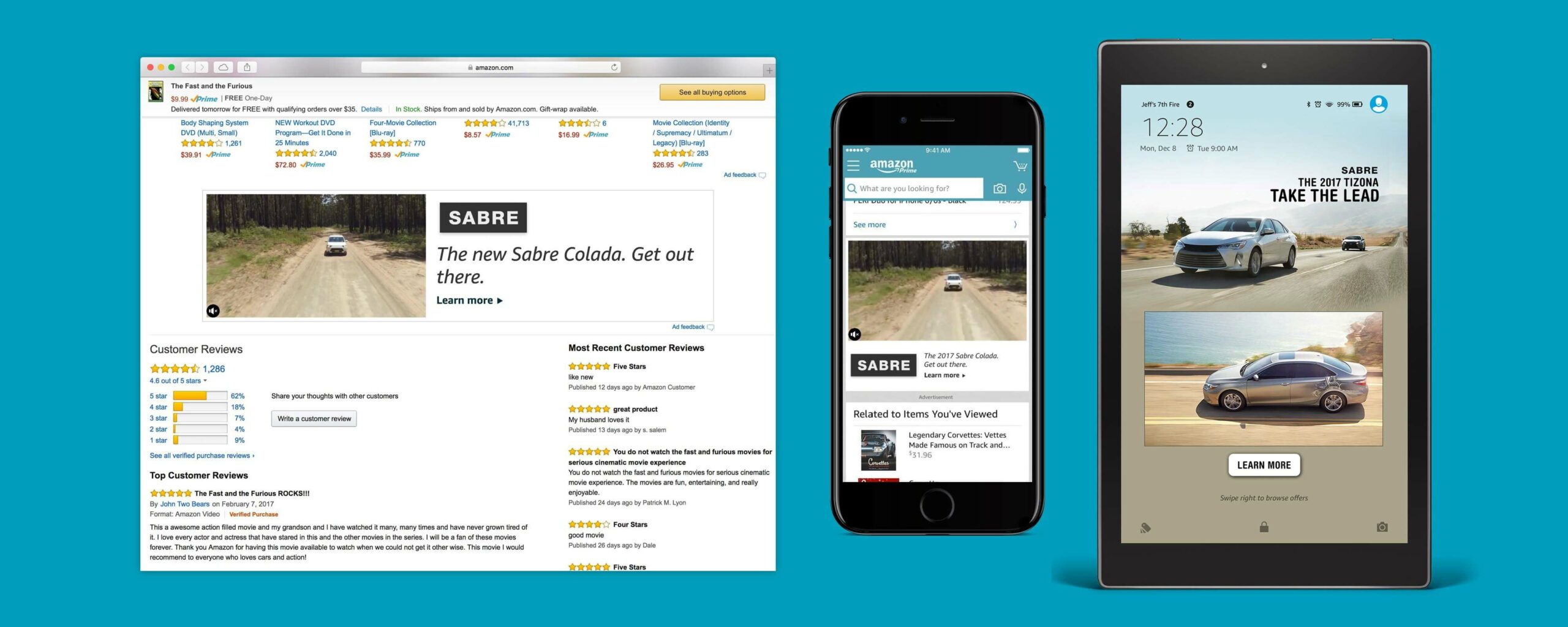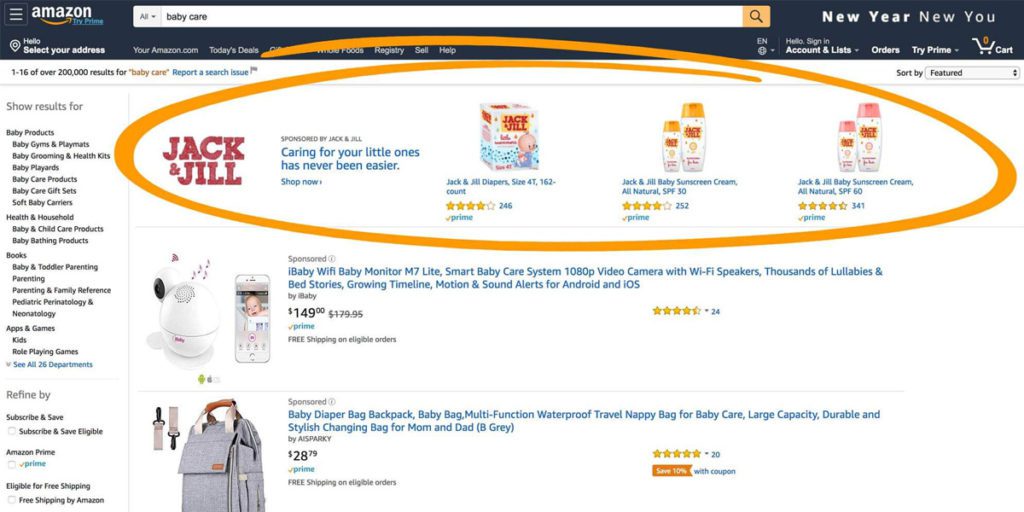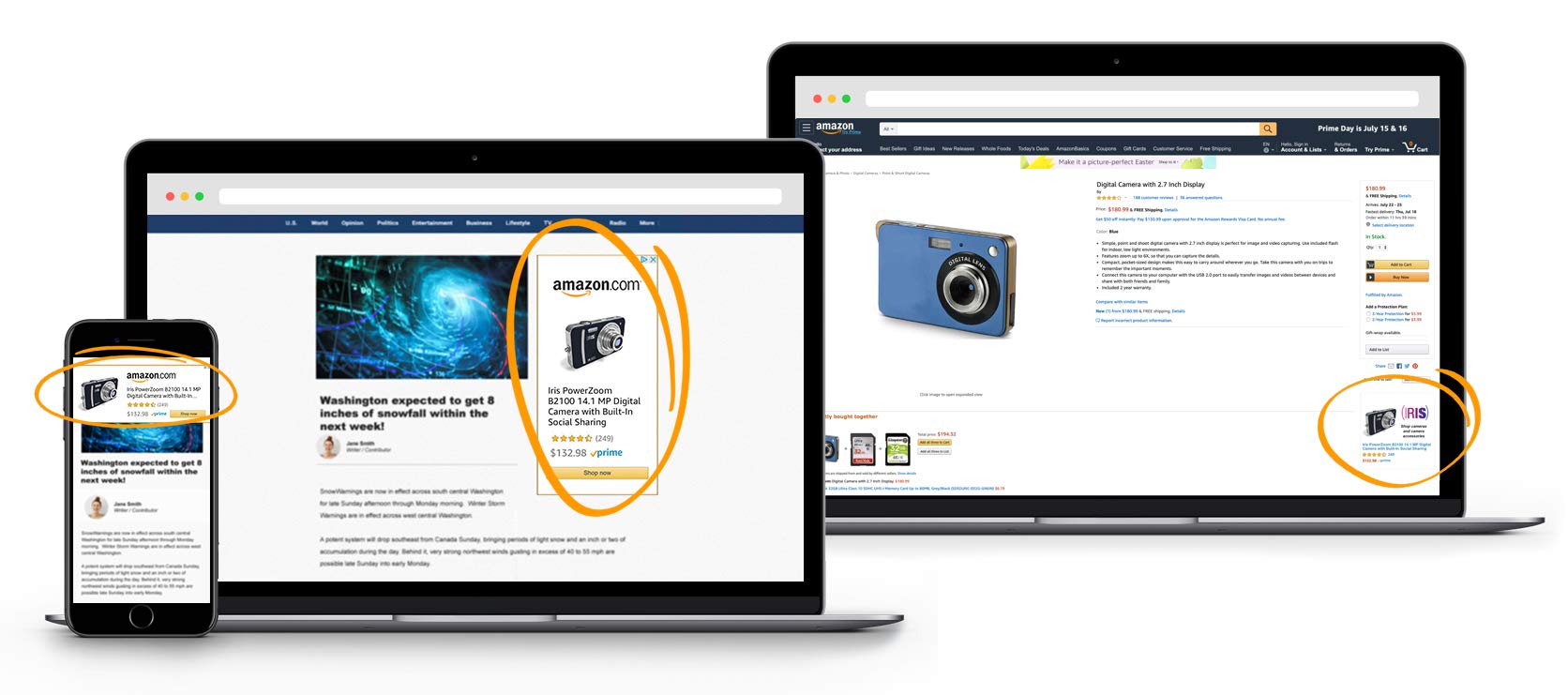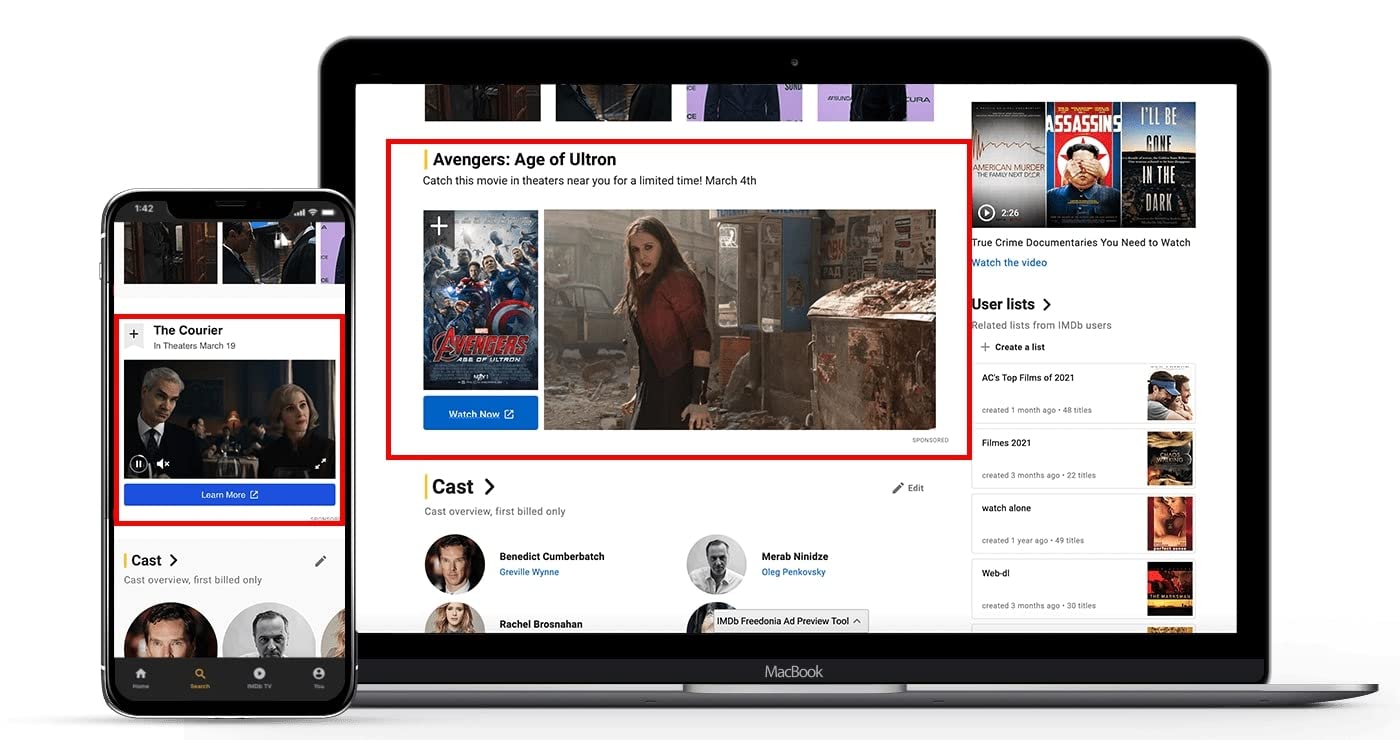Table of Contents
- 1 What Is Amazon Ads (Advertising)?
- 2 Getting Started with Amazon PPC Ads
- 3 Types of Amazon ads
- 4 Creating Successful Amazon Ad Campaigns
- 4.1 1. Determine your advertising goals
- 4.2 2. Choose the right products to advertise
- 4.3 3. Craft clear, concise, and compelling product detail pages
- 4.4 4. Place your ads strategically
- 4.5 5. Test and optimize: Sponsored Brands vs. Sponsored Products
- 4.6 6. Manage your feedback with SageMailer
- 4.7 7. Category-specific targeting
- 4.8 8. Utilize negative keywords
- 4.9 9. Use product listing monitoring tools like SellerSonar
- 5 Enhancing Brand Awareness with Amazon Video Ads and Stores
- 6 Conclusion: Amazon Advertising Strategy
As the leading e-commerce platform, Amazon is the most favored choice among online shoppers, amassing an impressive global user base of over 300 million active customers. This vast consumer network presents an enticing prospect for sellers seeking exponential growth, and Amazon Marketing Services (AMS) serves as the gateway to tapping into this potential.
Amazon Advertising plays a pivotal role in helping sellers reach their target audience by strategically showcasing their products to customers with relevant interests, using carefully selected keywords, and capitalizing on buyer preferences. Nevertheless, many new sellers struggle to harness its power effectively despite its immense potential. In this all-encompassing guide by SageMailer, we unveil the secrets to mastering Amazon Ads and understanding the advertising cost of sales, unlocking the door to the sales success you truly deserve!
What Is Amazon Ads (Advertising)?

Formerly recognized as Amazon Marketing Services (AMS), Amazon’s Advertising stands as a powerful tool, operating in a manner similar to Google and Facebook Ads.
Its primary purpose is empowering sellers and businesses to promote their products precisely, targeting specific audience segments. Leveraging Amazon’s vast user base, this advertising platform provides invaluable insights into users’ purchasing behaviors, allowing sellers to optimize their digital strategies with data-driven decisions.
At the core of Amazon Ads lies the pay-per-click ad model, wherein sellers or advertisers remit payments to AMZ every time a user clicks on their ad.
Within this versatile platform, sellers can run diverse types of digital advertisements, including Amazon Sponsored Ads, Sponsored Product Ads, and Product Display Ads. Beyond just displaying ads on the AMZ website, Amazon Advertising extends its reach by enabling sellers to publish video advertisements, disseminating them across third-party apps and platforms through the Demand Side Platform (DSP). This multipronged approach expands the advertising potential for sellers, including those looking to build their amazon brand, and opens up new horizons to reach their desired audience.
To access Amazon Advertising and manage your ad campaigns, you need to sign in to your account. After successful Amazon Ads login, you’ll be taken to your dashboard. From there, you can access various tools and features to create, manage, and optimize your ad campaigns.
Benefits of Amazon Advertising Services
Amazon Advertising offers a wide array of benefits for sellers and businesses looking to boost their online presence and drive sales. Some of the key advantages include:
- Access to a vast customer base: With over 300 million active users worldwide, the marketplace provides a massive audience for sellers to showcase their products to potential customers.
- Precise targeting options: Amazon Advertising allows sellers to target specific customer segments based on demographics, interests, and purchasing behavior, increasing the chances of reaching the right audience with relevant ads.
- Data-driven insights: The platform offers valuable data and analytics, providing sellers with detailed performance metrics and consumer behavior patterns, which can be used to refine ad strategies and improve campaign effectiveness.
- Cost-effective pay-per-click model: Sellers only pay when a user clicks on their ad, ensuring that advertising costs align with actual engagement, making it a cost-effective approach for advertising.
- Diverse ad formats: AMZ Advertising supports various ad formats, such as Sponsored Ads on Amazon, Sponsored Product Ads, Product Display Ads, and Video Ads, catering to different marketing objectives and allowing for creative and engaging campaigns.
- Integration with seller tools: The advertising platform seamlessly integrates with other Amazon seller tools and services, enhancing overall efficiency and providing a holistic selling experience.
- Cross-device visibility: AMZ Advertising ensures that ads are displayed across various devices, including desktops, smartphones, and tablets, maximizing the reach and potential engagement with customers.
- Brand visibility and recognition: By strategically placing ads within relevant search results and product pages, sellers can increase brand visibility and recognition, leading to improved trust and customer loyalty.
- Customizable budgets and campaign control: Sellers can set their advertising budgets and control their campaigns, enabling them to scale their advertising efforts per their business needs and goals.
Amazon’s Advertising business model explained
AMZ Ads operate under the pay-per-click (PPC) funding model, which essentially means that you are only charged when a user clicks on your ad. It’s a fair and cost-effective approach, ensuring you pay for actual engagement.
Now, let’s delve into the intriguing relationship between ads and organic search on Amazon. Picture it like this: Amazon’s ultimate aim is to drive sales, and the most effective way to achieve that is by displaying high-converting, best-selling products that are relevant to a user’s search query. Therefore, if your product boasts a strong sales history and garners positive feedback, it becomes more likely to secure a higher position in organic search rankings, helping you to sell products on Amazon.
But wait, there’s more. Here’s a fascinating tidbit – investing in Amazon ads can significantly impact your product’s organic ranking in a positive way. That’s right! As your sales and feedback improve through Amazon advertisements, your product’s organic ranking also experiences a boost.
So, if you’re keen on increasing the visibility of your product and reaching a broader audience on AMZ, incorporating ads into your strategy is undoubtedly worthwhile. The dual benefit of gaining immediate visibility through advertising on Amazon and boosting organic rankings makes it a powerful tool for enhancing your product’s presence on the platform.
Getting Started with Amazon PPC Ads
If you’re an Amazon seller looking to expand your reach and boost sales, Amazon Ads can be a game-changer. This powerful advertising platform allows you to showcase your products to millions of potential customers on the Amazon marketplace, increasing visibility and driving conversions. But before you dive in, it’s essential to understand the basics and make informed decisions to achieve success.
Should I advertise on Amazon?
The first question to address is whether advertising on the platform is the right choice for your business. Amazon Ads can be highly effective, especially if you have products with good demand and competition on the platform. Conduct thorough market research to evaluate the potential for your products and assess your target audience’s buying behavior on the platform.
Amazon Advertising costs: budgeting for success
Understanding the costs associated with Amazon Ad management is crucial for effective budgeting and maximizing your return on investment (ROI). With the pay-per-click (PPC) model, you only pay when a user clicks on your ad, which can be cost-effective if managed well. However, the cost per click varies depending on factors such as product category, competition, and the quality of your ad campaign. To set a reasonable budget, consider your advertising goals, the lifetime value of your customers, and your [profit margins](https://sagemailer.com/blog/amazon-roi/). Start with a conservative budget and monitor the performance of your ads closely. As you gain insights into the effectiveness of your campaigns, you can adjust your budget accordingly. Keep in mind that the advertising platform provides data-driven analytics that can help you make informed decisions about your budget allocation.
AMZ offers different types of ads, including Self-Serve Ads and Premium Ads. Self-serve Ads, also known as Sponsored Products and Sponsored Brands, allow you to create and manage your campaigns, providing more control over your budget and targeting options. On the other hand, Premium Ads, such as Sponsored Display and Video ads, offer additional features and exposure on and off AMZ.
When choosing the right approach for your Amazon Ads management, consider your advertising goals, budget constraints, and the type of products you sell. Self-Serve Ads are generally more accessible for sellers with limited budgets, while Premium Ads can be suitable for those looking to make a bigger impact and gain exposure beyond Amazon’s platform. Additionally, evaluating various advertising options will help you direct traffic to your Amazon store effectively and achieve your sales objectives through running ads.
Crafting compelling Headline Ads
Your ad’s headline is the first thing potential customers see, making it critical to craft compelling and attention-grabbing headlines. A well-crafted headline should be clear, concise, and relevant to the customer’s search query. Incorporate relevant keywords and highlight your product’s unique selling points to entice users to click on your ad.
Invest time in A/B testing different headlines to determine which ones perform best. Continuously optimize and refine your ad copy based on customer feedback and performance data to ensure the most effective and engaging headlines for your campaigns.
Types of Amazon ads
As you venture into the realm of Amazon Advertising, it’s essential to understand the various types of ads available to showcase your products and connect with potential customers. Each ad type offers unique features and targeting options, enabling you to tailor your marketing strategies for optimal results.
Sponsored Brands

Previously known as Headline Search Ads, these ads empower brands to promote multiple products and direct traffic to custom landing pages or Stores. They prominently appear at the top of search results, serving as a powerful tool for brand building. However, sellers must be accepted into the Brand Registry program to utilize Sponsored Brand Ads.
Sponsored Products

Among the most popular and effective ads, Sponsored Amazon Product Ads can target specific keywords or subjects, appearing both above and within search results on desktops and above or below on mobile devices. By strategically targeting competitors, these ads redirect potential customers to the seller’s page instead.
Product Display ADS

Positioned at the bottom right of a product listing, below the “Add to Cart” section, Product Display Ads are a useful means to cross-promote a seller’s own products or target specific products offered by competitors. Unlike Sponsored Ads, Product Display Ads feature one product, giving sellers more control over ad placement.
Video Ads

These captivating video ads can be placed on various web properties and Amazon-owned sites like IMDb and Amazon.com. Video ads serve as a compelling tool to capture audience attention and drive engagement.
Stores
Creating Successful Amazon Ad Campaigns
When it comes to advertising on Amazon, a well-planned and executed ad campaign can significantly boost your product visibility and drive sales. So, how to advertise on Amazon? To achieve success with your AMZ Ads, consider the following key steps:
1. Determine your advertising goals
Begin by defining clear and specific advertising objectives. Are you looking to increase sales for a particular product, promote a new product launch, or enhance brand awareness? Understanding your goals will help tailor your ad campaigns for maximum effectiveness.
2. Choose the right products to advertise
Not all products may benefit equally from advertising. Identify your top-performing and high-margin products to prioritize in your ad campaigns. Focusing on these products can lead to a higher return on investment (ROI) and overall campaign success.
3. Craft clear, concise, and compelling product detail pages
Ensure that your product detail pages are optimized and compelling. This includes high-quality images, detailed product descriptions, and engaging copy. A well-optimized product page will not only attract potential customers but also improve the conversion rate of your ads.
4. Place your ads strategically
Strategic ad placement is crucial for driving results. Choose relevant product categories and subcategories to target, ensuring your ads reach the right audience. Additionally, consider placing ads on competitor product detail pages to increase exposure to potential customers.
5. Test and optimize: Sponsored Brands vs. Sponsored Products
AMZ offers various ad formats, including Sponsored Brands and Sponsored Products. Test both formats to see which performs better for your products and objectives. Sponsored Brands are effective for brand visibility, while Sponsored Products target specific keywords and boost product discoverability.
6. Manage your feedback with SageMailer
Feedback is crucial for establishing trust with potential customers. SageMailer can help automate the process of gathering reviews and feedback by sending follow-up emails to your buyers.
The tool uses the “Request a Review” button in Seller Central, so it’s safe and 100% compliant with Amazon rules. You can use it even if your seller account has limitations on sending Buyer-Seller messages.
Moreover, with its convenient Response Center, you can access multiple marketplaces from a single dashboard and manage your buyer messages with pre-created templates.
Sign up for a free 30-day trial to benefit from its features – no credit card is needed!
7. Category-specific targeting
Leverage category-specific targeting to refine your ad reach. By targeting specific product categories, you can ensure your ads appear in front of customers with a strong interest in products like yours.
8. Utilize negative keywords
Negative keywords can help refine your targeting and avoid irrelevant impressions. By excluding certain keywords that are not relevant to your products, you can ensure your ads are shown to the most relevant audience, leading to higher conversion rates.
9. Use product listing monitoring tools like SellerSonar
Consider utilizing product listing monitoring tools like SellerSonar that provide in-depth analysis of your and your competitor’s product listings, pricing, keyword performance, customer reviews, and much This enables you to identify market trends, spot opportunities, and adjust your pricing strategies to remain competitive.
For example, you can discover high-performing keywords that resonate with your target audience and optimize your product listings to maximize visibility and ranking in Amazon’s search results.
Ready to try? Register for a free 29-day trial now!
Enhancing Brand Awareness with Amazon Video Ads and Stores
In today’s competitive e-commerce landscape, brand awareness plays a crucial role in driving customer loyalty and sales. Amazon offers powerful tools like Video Ads and Stores to help brands effectively enhance their presence and engage with their target audience. Let’s explore how these tools can be leveraged to boost brand awareness on the platform.
Leveraging Amazon Video Ads for engaging content
Video Ads provide a compelling way to tell your brand’s story and showcase your products to millions of potential customers. To make the most of this platform, consider the following practical tips:
- Short and impactful: Keep your videos concise and impactful. Captivate the audience within the first few seconds to encourage them to watch the entire video.
- Highlight USPs: Use the video to highlight the unique selling points of your products. Showcase how your offerings stand out from the competition and fulfill customers’ needs.
- Call-to-action: Include a clear and compelling call-to-action in your video, directing viewers to take specific actions like visiting your Amazon Store or making a purchase.
- Test and optimize: Continuously test different video formats, messaging, and targeting options to identify what resonates best with your audience. Use data-driven insights to optimize your video ad campaigns.
Amazon Stores: a powerful branding tool
Amazon Stores provide brands with a customizable and immersive shopping experience within the AMZ ecosystem. To maximize the potential of your Amazon Store, take into account the following recommendations:
- Consistent branding: Maintain a cohesive brand identity throughout your store. Use your logo, colors, and brand visuals to reinforce your brand’s presence and create a cohesive shopping experience.
- Compelling content: Craft engaging and informative content for your Store. Utilize a mix of images, videos, and well-written product descriptions to captivate customers and communicate the value of your products.
- Organized navigation: Organize your products into relevant categories to make navigation easy for customers. Use logical groupings and clear labels to guide visitors through your product offerings.
- Promotional banners: Use eye-catching banners to promote new product launches, limited-time offers, or seasonal campaigns. These banners can create a sense of urgency and drive immediate action.
- Monitor performance: Regularly track the performance of your Amazon Store using the built-in analytics tools. Track page visits, click-through rates, and conversion rates to understand customer behavior and optimize your Store.
Conclusion: Amazon Advertising Strategy
So is it worth it? Definitely! With over 197 million monthly visitors, advertising on Amazon can give your business significant exposure in the e-commerce world. Moreover, these ads have proven to be highly effective at driving sales, with up to a 10x return on ad spend reported by businesses.
However, successful Amazon advertising requires strategic planning and experimentation. Optimize your campaigns by structuring them well, using compelling ad copy, and bidding on popular brands in your niche. To make the most of your AMZ advertising, consider using SageMailer. With the tool, you will automate the process of soliciting and managing reviews, ensure a steady stream of authentic feedback, and drive conversions.
Explore SageMailer today with a trial account to see how it can take your selling to the next level!

